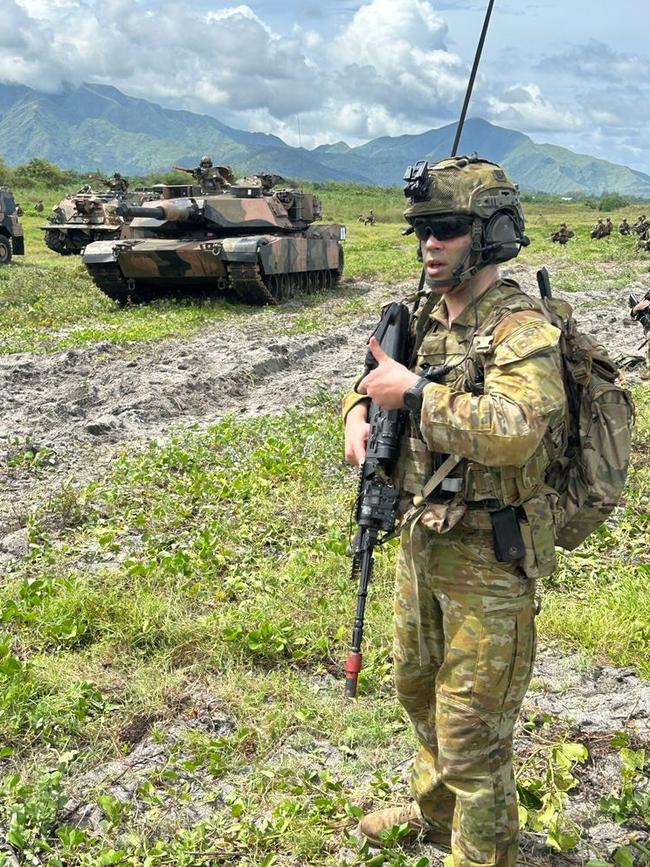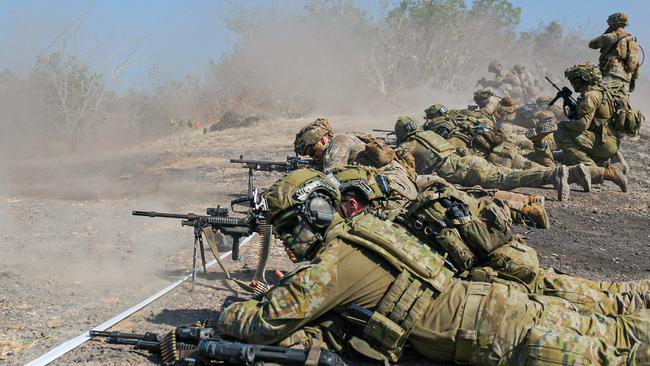Army moves north: 500 new troops to be based in Townsville
Tasking Townsville with greater military responsibility has been labeled the right decision by a former Army Chief. See why and what’s planned.
Townsville
Don't miss out on the headlines from Townsville. Followed categories will be added to My News.
Making Townsville a strategic imperative for the defence of Australia was the right decision but nationally the Army was too small to make an impact.
Reacting to the announced restructuring to the service, former Chief of Army retired Lt General Peter Leahy said the changes were needed and tasking Townsville with greater military responsibility was the right decision.
But he questioned the merit of stripping regiments of their readiness by making them all specialised as opposed to carrying a broader range of capability for potential immediate use.
He also added it came back to the same problem, the Army was simply too small for the tasks at hand.

“It‘s sensible with the new tasking Army has been given and Townsville is the right spot, north east affinity and that link into the Pacific and avoids putting too many people up in Darwin which is a nice city but not great to be as a soldier and family living up there,” he said.
“But my real concern is the broader issues creating an unbalanced force, it’s too much specialisation for the Army which means there will not be broader options available should Australia be involved in something … it’s essentially too big a bet on the fact there is going to be just naval and air assets required for whatever future conflict might occur.”
He added the size of Army was smaller than when he joined in 1971.
“For me it's obvious from the range of tasks they’ve been given that the Army is just too small. It’s getting to a point of real danger of being unable to maintain readiness and rotation forces and concurrency in that the Army is just too small and there’s this overspecialisation.”

The current acting Chief of Army Major General Richard Vagg began his pitch speaking to troops in Townsville on Thursday and said it was about making the best of what he had.
“This is about organising Army to train as we would fight and making the most of the resources we have been assigned,” he said.
“These changes will deliver world class, relevant and credible combat capabilities that are focused and optimised for operating in the littoral environments of our region, on land, at sea and in the air. Our aim is to limit the disruption to our people and their families as we make these important changes. Our people are our Army and I thank each and every one for your service and commitment to adapting our Army.”
WHY TOWNSVILLE IS GETTING 500 NEW TROOPS
Australian Army infantry troops, tanks and other armoured fire power will be relocated to the nation’s north in the biggest shake-up to the armed forces in decades, with 500 new troops to be based in Townsville.
The great march northward will see South Australia lose all its full-time infantry, its M1A1 Abrams tanks and armoured personnel carriers, to be relocated to Townsville.
But it will see the state become the base for a new “fires brigade”, the 10th Brigade previously disbanded in 1942, to operate all High Mobility Artillery Rocket System (HIMARS) and National Advanced Surface-to-Air Missile System (NASAMS) capabilities.

Barely a brigade or battalion will be unaffected by the changes with relocation of personnel and their families to begin from next year into 2025.
While the number of personnel required to move will be staggered, it will see about 500 people move to Townsville on top of the already 4000 based there, 100 to Darwin in the immediate with up to 200 more depending of Army’s amphibious requirement and Brisbane brought up to full strength of about 4500 personnel.
While Adelaide will lose 800 to 900 personnel in the short term, it will regain that many through the fire brigade.
All governments from affected States are to be briefed on the relocation of military population and assets.
The changes follow the Defence Strategic Review (DSR) priorities which demanded wholesale restructuring and a shift from a Middle East focus to more agile and focused specialised combat brigades “optimised” for littoral manoeuvre about the Pacific island chain.
The DSR concluded the Army was no longer fit for purpose under its current structure and would not be equipped to meet new strategic challenges.

Army considers the changes “significant”, on par with reorganisation that had been required for World War 2 and the lengthy 20-year commitment to the Middle East.
While it will be an expensive exercise, the cost benefit will come over time since on average it costs $6 million a year just to move armoured vehicles from Brisbane to Shoalwater Bay for exercises.
Defence Minister Richard Marles said the Army needed to adapt.
“These changes involve some hard decisions but these decisions are necessary to build the Army Australia needs,” he said.
“This will mean Army has a concentration of people and capabilities in Australia’s north, making it easier to deploy for training, major exercises or to support our partners and allies in the region.”

Consolidation of Army Attack Apache helicopters and medium lift Chinooks also to Townsville elevates it as one of Australia’s most critical Army garrison towns.
The 7th Battalion currently based at RAAF Base Edinburgh in SA and the 5th Battalion in Darwin will also merge to be based in the Top End with Edinburgh’s 1st Armoured Regiment to be “re-roled as an innovation and experimentation unit” to deliver and integrate emerging technologies.
The rationale behind this brigade is to have missiles close to Woomera range for training and to “project from the rear” with the air portable missile systems able to move north in the event of crisis.
WHAT THE CHANGES WILL MEAN
•The 1st Brigade, based in Darwin, will be a light combat brigade and have a “modest” infantry troop increase to be “agile and quick to move”
•The 3rd Brigade, based in Townsville, will be an armoured combat brigade
•The 7th Brigade, based in Brisbane, will be a motorised combat brigade with the M1A1 Abrams tanks and M113 armoured personnel carriers withdrawn with a focus instead on Hawkei, Bushmasters and Boxer combat reconnaissance vehicles. More Army personnel to relocate here
• From 2025, the largely Reservist 9th Brigade will change its role from an armoured combat brigade to a new “security and response” brigade
• A new 10th Brigade will be raised, having been disbanded in 1942, as a “fires brigade” to operate High Mobility Artillery Rocket System (HIMARS) and National Advanced Surface-to-Air Missile System (NASAMS) capabilities
•The 5th Battalion and the 7th Battalion will be merged to become 5th/7th Battalion, the Royal Australian Regiment, and will be based in Darwin. Currently the 7th is in Adelaide they will relocate from December 2024. Will require tanks, armoured personnel carriers and full-time infantry to be withdrawn from Adelaide.
•The 1st Armoured Regiment will be “re-roled as an innovation and experimentation unit” to deliver and integrate emerging technologies and remain in Adelaide
• The acquisition of Littoral Manoeuvre Vessels amphibious landing craft (medium and heavy) will be expanded and could be located in Darwin, North Queensland and Brisbane
•The 1st Aviation Regiment will relocate from Darwin to Townsville from 2025 as previously announced
• Consolidation of armoured vehicles in Townsville
• Consolidation of Army Attack (Apache) and medium lift Chinooks in Townsville
COMMENT: ARMY CHANGES ‘CHALLENGING BUT NECESSARY’
In April, an emotional Army chief Lieutenant General Simon Stuart took to YouTube for an extraordinary appeal to troops to hold the line.
He looked and sounded shattered as he discussed the Defence Strategic Review that with a stroke of a pen had just abolished three armoured battalions and a regiment and cut incoming hardware acquisitions.
Technology had changed the nature and threat of future war fighting, troop recruitment and retention was not being sustained and the once vaunted service had simply failed to keep up.
But he assured sweeping changes were coming to make Army great again and today they arrived with one of the biggest mobilisations, consolidations and mindset shifts in decades.

On paper they look extreme – such as withdrawing all tanks, armoured carriers and full-time infantry out of Adelaide – but there should be no doubt these wholesale changes are critically needed.
Army had moved their heavy armour to Adelaide 13 years ago at a cost of $1 billion because it allowed for year-round training out of the wet season of the north so it may seem odd to move them back again.
But then since that 2010 decision the relevance of maintaining such a capability to that level has evolved, no-one is expecting to have to deploy tanks on the streets to fight a war here like a Ukraine-Russia conflict.
It is more likely we’ll deploy long-range missiles and so re-purposing South Australia for this task makes sense. On the ADF intelligence mapping the arc of ground-based missile attack from a potential adversary such as China wipes out the top half of Australia with SA just out of reach. At current tech analysis at least.
Military firepower does need to refocus to the north and be focused on littoral manoeuvres deployments in our immediate area to maintain regional peace and security.
Fighting units will be smaller, more capable, formations more specialised with a consolidation of assets to move away the outdated position that had allowed regiments to be a jack of all, master of none.
As Stuart said, the changes will be challenging.
But they are necessary and their adoption should carry a sense of urgency.
More Coverage
Originally published as Army moves north: 500 new troops to be based in Townsville




